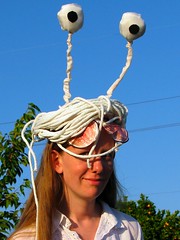Flickr went down today. There was some sort of data storage issue that required them to transfer twenty terabytes of data. To cope with the downtime, they put up a message that said (in a stroke of brilliance) “Arrggh! Our tubes are clogged!”, and announced a coloring contest: print out the web page and color in the dots– a pair of circles in the shape of their logo. Take a photo of your creation and post it to Flickr, and (when the site returns) post it, tagged with flickrcolourcontest.
We printed out the page and sent Christian to get his crayons. We instructed him to scribble thoroughly between the lines with red and brown. That completed, Lenore donned the Flying Spaghetti Monster crown for our contest entry.
As of this writing, about three hours since Flickr came back online, there are about 450 entries. Ours is one of them.











